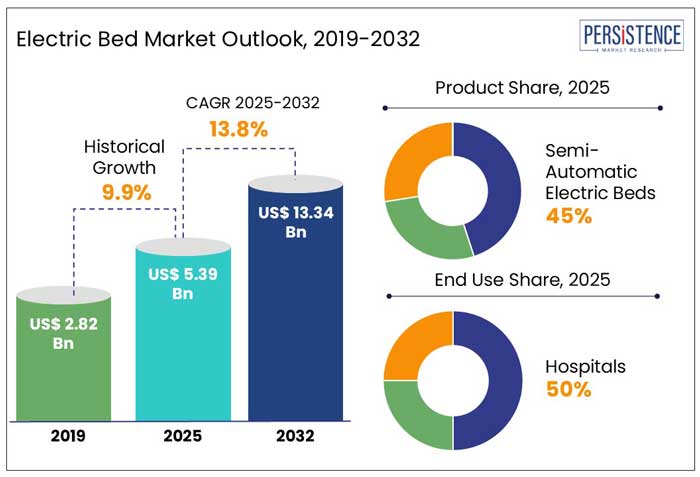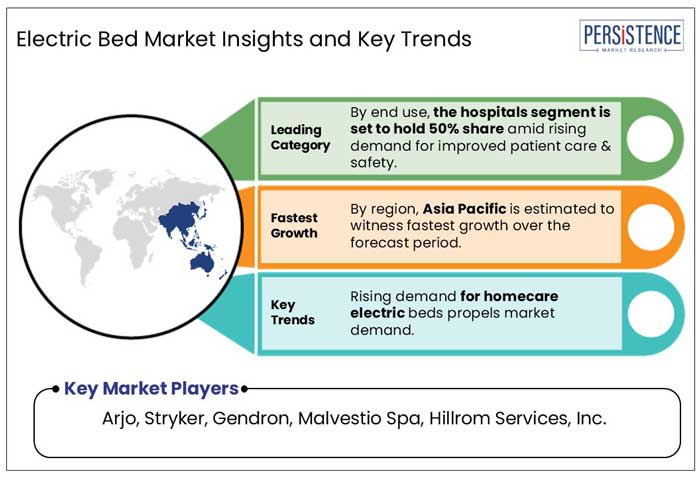Industry: Healthcare
Published Date: March-2025
Format: PPT*, PDF, EXCEL
Delivery Timelines: Contact Sales
Number of Pages: 250
Report ID: PMRREP35161
The global electric bed market size is anticipated to rise from US$ 5.39 Bn in 2025 to US$ 13.34 Bn by 2032. It is projected to witness a CAGR of 13.8% from 2025 to 2032.
The electric bed market has witnessed significant growth, driven by various demographic and technological factors. The aging global population significantly impacts market demand, as the need for such electric beds caters to patient care and diagnostics.
According to the World Population Prospects 2022, individuals aged 60 and above are expected to comprise 16% of the total population by 2050, up from 10% in 2022. This demographic shift increases the need for electric beds that cater to the elderly's comfort and medical requirements.
Innovations in the healthcare devices also playa s pivotal role in the market’s progress. As modern electric beds are now equipped with integrated sensors and connectivity features, which help monitor patient movements and vital signs. With such innovations enhancing patient safety and reducing the workload on healthcare providers, the market is experiencing steady growth over the forecast period.

Key Highlights of the Electric Bed Market
|
Global Market Attributes |
Key Insights |
|
Market Size (2025E) |
US$ 5.39 Bn |
|
Market Value Forecast (2032F) |
US$ 13.34 Bn |
|
Projected Growth (CAGR 2025 to 2032) |
13.8% |
|
Historical Market Growth (CAGR 2019 to 2024) |
9.9% |
Rising Elderly Populations & Advancements in Patient Care Technologies Aided Market Growth
During the historical period from 2019 to 2024, the electric bed market experienced steady growth, driven primarily by the rising elderly population, increasing hospital admissions, and advancements in patient care technologies.
Hospitals and long-term care facilities adopted electric adjustable beds to enhance patient comfort and caregiver efficiency. The surge in home healthcare solutions created a demand for customizable electric beds. However, high costs, limited awareness in emerging markets, and inconsistent reimbursement policies restricted market penetration.
Advent of AI-Powered Smart Hospital Beds & Integrated Homecare Beds Augments Market Growth
Over the forecast period, the market is set for accelerated expansion, fueled by AI-powered smart hospital beds, IoT-integrated homecare beds, and supportive government policies. As more patients choose home-based treatment over prolonged hospital stays, manufacturers are innovating affordable, ergonomic, and technology-driven electric beds.
With insurance providers extending coverage for home medical equipment, the global electric bed market is expected to grow at a strong CAGR, surpassing previous projections. Companies focusing on cost-effective, high-tech solutions will lead the next phase of market evolution.
Increasing Hospital Admissions and Healthcare Infrastructure Expansion Propel Market Growth
With rising chronic illnesses, post-operative care needs, and accident-related injuries, global hospital admissions are on the rise. With a newly built healthcare facility equipped with the latest electric ICU beds, designed for seamless patient mobility and caregiver assistance, caters to serve patients better.
Governments and private investors are heavily funding hospital expansions, particularly in Asia Pacific and Latin America, where healthcare infrastructure is evolving rapidly. The increasing number of healthcare facilities directly fuels the demand for automated hospital beds, enhancing both patient comfort and medical efficiency.
As hospitals prioritize electric medical beds with customizable settings, features like height adjustability, pressure relief, and remote-controlled operations are becoming industry standards, further propelling the market growth.
High Costs and Affordability Challenges the Adoption of Electric Beds
The high cost of electric beds remains a major restraint in market growth, particularly in developing regions where healthcare budgets and insurance coverage are limited.
A middle-class family caring for an elderly parent at home would quickly get discouraged by the hefty price tag, realizing that electric hospital beds, especially those with advanced features like smart sensors and remote controls, are a significant financial investment.
Hospitals and long-term care facilities often struggle to allocate funds for automated hospital beds, delaying purchase decisions. While premium brands dominate the market, the demand for more cost-effective electric beds is rising, pushing manufacturers to develop affordable yet high-quality alternatives.
Rising Demand for Homecare Electric Beds Propels Market Expansion
With healthcare costs soaring, more patients are choosing home-based treatment and long-term care over extended hospital stays. This shift has created a major opportunity for manufacturers to design affordable, customizable, and ergonomic home-use electric beds.
As families prioritize homecare solutions, demand for beds with adjustable height, reclining options, and pressure-relief mattresses is on the rise. Government programs and insurance providers are expanding coverage for medical homecare equipment, further fueling market growth.
Based on Product, the Semi-Automatic Electric Bed Dominates with 45% of the Market Share
The semi-automatic electric bed segment led the market with 45% of the total share. The dominance of semi-automatic electric beds can be ascribed to their cost-effectiveness and utility.
Semi-electric beds typically include motorized adjustments for the backrest and leg elevation, enabling patients to attain comfortable positions without the intricacies or expenses linked to fully automatic models.
Healthcare facilities, especially smaller clinics, and nursing homes aim to enhance patient care while adhering to financial constraints; semi-automatic electric beds provide a practical alternative. Their intuitive controls render them accessible to both patients and caregivers, hence increasing their demand across diverse healthcare environments.
Hospitals Lead the End Use Segment with 50% of the Market Share Owing to Rising Demand for Improved Patient Care & Safety
The hospital leads the end use segmentation of the market with 50% of the total market share. The expansion of the hospital segment can be ascribed to the rising demand for improved patient care and safety.
Hospitals are progressively implementing electric beds due to their sophisticated features that enhance patient comfort and facilitate medical procedures.
These beds provide effortless modifications in height and position, which is essential for individuals with restricted movement or those convalescing from surgery.
Incorporating smart technologies, including remote surveillance and automatic modifications, improves patient safety and caregiver efficacy, rendering these goods a favored option in healthcare environments.

North America Electric Bed Market Dominates with 44% Market Share Due to High Number of Hospital Admissions for Surgical Procedures
The North America electric bed market accounted for the largest revenue share of 44%, which is primarily attributed to the rising frequency of surgical procedures and hospital admissions.
The demand for electric beds has risen as healthcare facilities prioritize improving patient care and comfort, especially for those undergoing surgeries or needing long-term care.
The aging population in North America is contributing to an increase in chronic illnesses necessitating hospitalization, which eventually aids the market growth.
The senior population frequently necessitates specialized care, and electric beds provide advantages that are especially advantageous for elderly people.
U.S. Electric Bed Market
The U.S. accounts for the majority of the market share in the North American region, which has a substantial aging population.
The demographic change markedly elevates hospital admissions and surgical procedures, amplifying the demand for sophisticated medical equipment that provides improved comfort and flexibility for patients in treatment or recuperation.
Europe Electric Bed Market to Propel with the Rising Demand for Sophisticated Medical Equipment
The Europe electric bed market is propelled by the rising demand for healthcare solutions that improve patient comfort and recovery, with the aging population requiring sophisticated medical equipment.
Electric beds enhance patient mobility and promote superior care in both hospital and home environments. Incorporating smart technology into this equipment has enhanced growth, enabling features like remote-control adjustments that attract healthcare providers and patients.
Technological improvements have significantly contributed to market expansion, as incorporating smart technologies into this equipment has enhanced its adaptability for healthcare facilities and customers.
Asia Pacific Electric Bed Market Witness Substantial Growth Owing to Increased Patient Numbers with Chronic Diseases
The Asia Pacific region is projected to experience substantial growth during the forecast period due to the growing older population in nations like Japan and China, where the aging demographic is resulting in a heightened incidence of chronic diseases. The rise in medical tourism and the evolving healthcare infrastructure will significantly enhance market expansion over the forecast period.
China and Japan, being the leading market share holders in the region, cater to the growing revenue of the electric bed market. For instance, the electric bed market in China is anticipated to expand during the forecast period because of the increasing need for sophisticated devices in the healthcare sector, the aging demographic, and the rising incidence of chronic illnesses.
The electric bed market is highly competitive, with key players focusing on innovation, technological advancements, and strategic partnerships to expand their market share.
Companies are leveraging smart bed technology and advanced ergonomic designs to meet growing healthcare demands. Rising hospital admissions and increasing home care adoption are fueling market expansion.
Smaller players are gaining traction by offering cost-effective and customizable solutions. Competition intensifies as demand rises for adjustable hospital beds, smart electric beds, and homecare beds, driving new product developments and improved patient comfort solutions.
Key Industry Developments
|
Report Attributes |
Details |
|
Historical Data/Actuals |
2019 - 2024 |
|
Forecast Period |
2025 - 2032 |
|
Market Analysis Units |
Value: US$ Bn/Mn, Volume: As applicable |
|
Geographical Coverage |
|
|
Segmental Coverage |
|
|
Competitive Analysis |
|
|
Report Highlights |
|
|
Customization and Pricing |
Available upon request |
By Product
By Procedure
By End Use
By Region
To know more about delivery timeline for this report Contact Sales

The market is set to reach US$ 5.27 Bn in 2025.
Arjo, Stryker, Gendron, are a few leading players.
The industry is estimated to rise at a CAGR of 13.8% through 2032.
North America is projected to hold the largest share of the industry in 2025.
The market is anticipated to reach a valuation of US$ 13.34 billion by 2032.